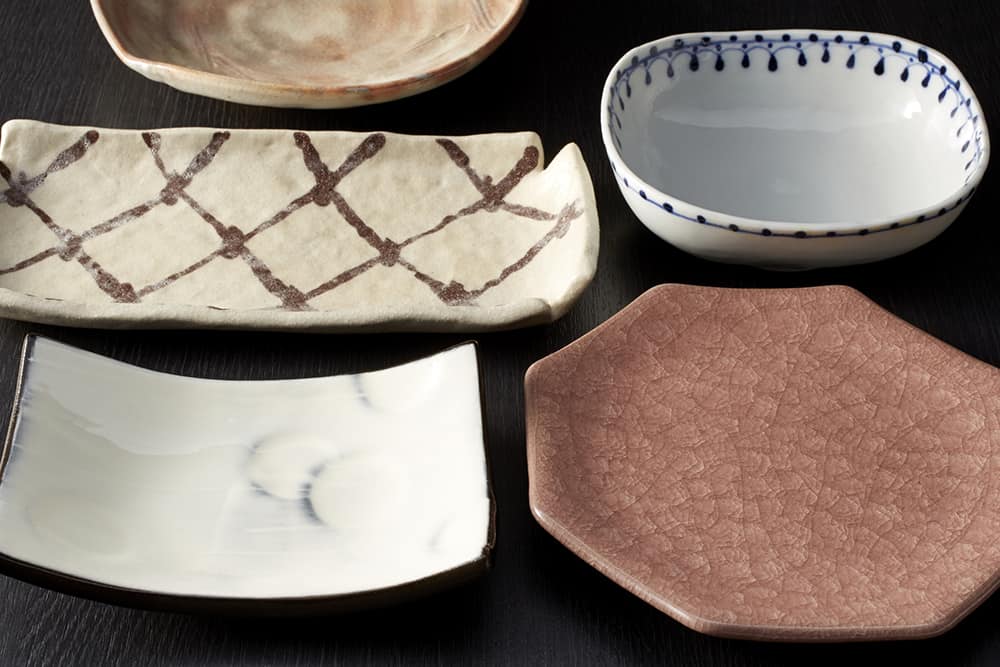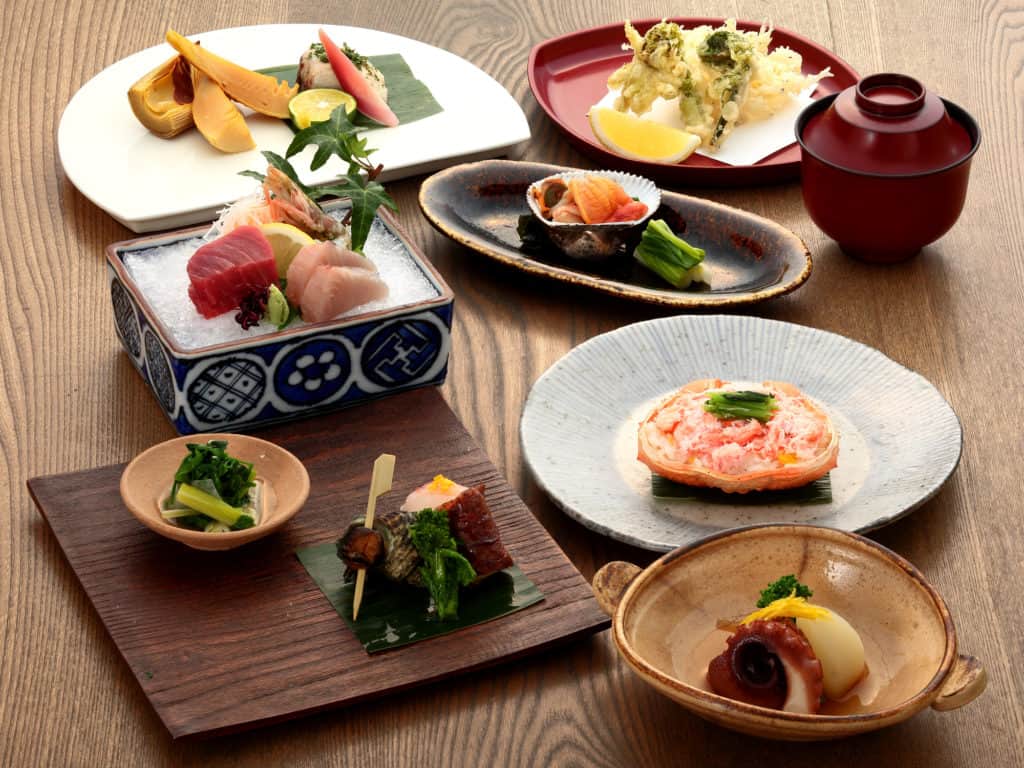All kinds of cuisine, not just Japanese food, go well with Japanese tableware. This can be attributed to the structure of a typical Japanese meal, which includes a main along with many side dishes, creating a need for small plates with a wide variety of chic designs. On top of their versatility, Japanese plates are light and durable. Brighten up your dining table by checking out these five specially selected Japanese plates!
Pros of Japanese Plates

・Simple designs that make the food stand out
While there are Japanese plates with modern, colorful designs, the ones with more traditional designs have muted colors which make the food stand out. This is what makes them suitable for any type of cuisine.
・Can easily find small sizes
A typical Japanese meal consists of a main, soup, and side dishes. This means that there’s a need for a wide variety of small plates, all with unique, chic, easy-to-use designs. Including side dishes in your meal is a great way to have a more balanced, nutritious diet. Why not pick up some small Japanese plates to do just that?
・Light and portable
In Japan, dishes are normally lifted close to one’s face when eating, so there is a strong preference for tableware such as light and small ceramic dishes and wooden bowls. They are handy when making Japanese-style meals, which have a lot of small portions of food, and have become staples in the Japanese kitchen.
Differences Between Production Regions

The texture, color, and even crafting techniques put into each piece of tableware in Japan can significantly change depending on where it was produced. Below, we cover some of the major production regions and what they specialize in.
・Tsugaru Biidoro (Aomori Prefecture)
These glass plates are made with the same techniques used to make glass fishing floats. They are mainly produced in the Tsugaru region of Aomori Prefecture. Since they aren’t made with molds, they have a “handmade” feel to them, and many of their designs are based off the four seasons.
More info: ▶ Japanese Crafts: A Guide to Tsugaru Vidro
・Kyoto-Kiyomizu Ware (Kyoto Prefecture)
The city of Kyoto was the center of Japanese politics and culture for 1,100 years. Despite this wealth, it never had good soil for pottery, so instead the local artisans chose to import clay from other parts of Japan and blend them together to develop truly unique pieces of art. The wares developed from this process are generally high quality and beautifully decorated.
More info: ▶ Kyo Ware/Kiyomizu Ware Guide: Japanese Ceramics (Pottery / Porcelain)
・Imari-Arita Ware (Saga Prefecture)
The first place in Japan that white clay (used in porcelain) was discovered was in Arita, Saga Prefecture, and the area was also the first place in the nation where porcelain was made. The resulting porcelain wares are known for their strong durability and gorgeous, colorful designs that stand out against the white clay.
More info: ▶ Imari-Arita Ware Guide: Japanese Ceramics (Porcelain)
・Hasami Ware (Nagasaki Prefecture)
This 400-year-old craft was developed and is produced mainly within the town of Hasami in Higashi Sonogi, Nagasaki Prefecture. It is known for its almost transparent white porcelain and detailed paintings. In recent years, the modern designs on Hasami tableware have gripped the hearts of the younger generation.
More info: ▶ Hasami Ware Guide: Japanese Ceramics (Pottery / Porcelain)
Related articles:
▶ Traditional Japanese Crafts: The Complete Guide to Japanese Ceramics
▶ The Complete Guide to Traditional Japanese Crafts
1. Tsugaru Scene Bean Plate Set | Tsugaru Vidro

Score: ★★★★☆
These dishes bring life to any dining table with their adorable, colorful coloring and simple handmade charm. They display the bountiful nature nestled within Tsugaru: the pink fluttering sakura of spring, the rich green of budding summer leaves, the deep blue of the clear sky and sparkling sea, and the yellow of the nanohana (rapeseed) blossoms splattered across the foot of Tsugaru’s mountains.
Size: φ3.93" * H1.18" (φ10.0 cm * H3.0 cm)
Brand: HOKUYO GLASS (Tsugaru Vidro)
Related articles:
▶ 5 Japanese Bowls You’ll Want to Decorate Your Pantry With
▶ 5 Chopstick Sets and Utensils That Will Make You Fall in Love with Japanese Cutlery
2. Flower Crystal (Blue) Plate | Kyoto-Kiyomizu Wares

Score: ★★★★★
Kiyomizu ware from Kyoto is known for its lightness, beautiful fit in the hand, and gorgeous decorations. This particular plate from TOUAN is coated with an original glaze that, after the firing process, makes it transparent and glittery like glass. It is fired at higher temperatures than normal, allowing the color to stay vivid and nearly as is. Despite its luxurious look, it does not look out of place at any ordinary dining table.
Size: Φ4.92" * H0.79" (Φ12.5 cm * H2.0 cm)
Brand: TOUAN (Kyoto-Kiyomizu Ware)
Related article: ▶ Kyo Ware/Kiyomizu Ware Guide: Japanese Ceramics (Pottery / Porcelain)
3. A Set Of 5 Colored Small Plates | Osaka Naniwa Pewter Ware

Score: ★★★★☆
These tin plates are made using techniques developed over 300 years. Tin is resistant to rust and color changes, and it’s also a great heat conductor, so cold foods will keep cold and hot foods will stay warm when served. The more you use them, the more muted their shine becomes and the more they start to take on a beautiful antique look.
Size: D1.73"~ * W1.92"~ (D4.4~ cm * W4.9~ cm)
Brand: OSAKA SUZUKI (Osaka Naniwa Pewter Ware)
4.Saikai Pottery Traditional Japanese Ai-e (Ukiyo-e) Indigo Patterns Porcelain Plates (5 Plates Set) 31302 from Japan

Score: ★★★★☆
These plates go with any meal thanks to their versatile coloring and size, which is common to see when serving up stewed dishes. They are deep, so they also go well with curry or pasta dishes.
Size: 8.66” x 7.87” x 1.57” (22 cm × 20 cm × 4 cm)
Brand: Saikai Pottery (Hasami ware)
Related article: ▶ Hasami Ware Guide: Japanese Ceramics (Pottery / Porcelain)
5. Plate Small Gloss White | Imari-Arita Wares

Score: ★★★★☆
Arita might be the origin of Japanese porcelain, but this plate is the product of traditional techniques mixed with modern sensibilities. It was part of a 2016 project to celebrate the 400th anniversary of Arita ware, from Dutch designer Timen Schmelders, who lived in the area. A technique called “shinogi” was used to accent the sides of the plate, giving it a sophisticated appearance.
Size: φ5.51" * 0.78" (Φ14.0 cm * 2.0 cm)
Brand: UTSUA (Imari-Arita Ware)
Related article: ▶ Imari-Arita Ware Guide: Japanese Ceramics (Porcelain)
If you want to give feedback on any of our articles, you have an idea that you'd really like to see come to life, or you just have a question on Japan, hit us up on our Facebook, Twitter, or Instagram!
*These products may not be able to be shipped to certain countries. Please see the retailer's website for more information.
The information in this article is accurate at the time of publication.
